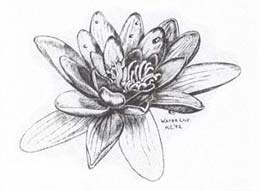
 |
something, chances are that there is stuff down there. Plant material, silt, soil, tree leaves, sticks, dead frogs, all contribute to the production of algae once the water temperature goes up in late spring. Get yourself a good quality pool skimmer with fairly fine gauge net, and a telescoping handle if your pond is large, a sturdy handle will be worth the money because you'll be able to scoop up heavier loads of stuff and the job will go faster. Pull out the pots of water lilies and other plants if you can, or move them all to one side while you work. Pump out about half of your pond water, I usually empty down to the first shelf level, then I can stand on the edges.
NEVER EMPTY YOUR POND COMPLETELY. There are actually some good nutrients and good bacteria in your present pond water, consider it like a 'starter dough' for bread. Unless you've had a serious problem with loosing fish to a disease or bacteria, it is best to leave at least half of your pond water. When you've finished scooping the debris out of the bottom (it doesn't have to be perfect), I usually take a rag or sponge and scrape down the sides of the liner and get the filiment algae that remains and sometimes you'll get snails and snail eggs this way
also. When I'm lazy, I just use a high pressure hose and wash off the sides, but then you have to scoop again because there's stuff in the bottom. Replace the plants and refill the pond. You're all set except for one step, and that is repotting and dividing your plants. Spring is the only time you can do this successfully. I'll have complete information on that next time. This is very important to the health of your water plants. Most of them grow in a horizontal direction (water lilies, iris, pickerel rush) and they will stop flowering, and may die completely if they are up against the side of the container. Check out my video for instructions on building a garden pond.
 |
|
Water
Lily
|
CLEAR WATER - This is always a big question for pond keepers, how to keep their water clear. First let's talk about garden ponds; that is, ponds with plants but no fish. Your pond needs to have at least half of its area 18"-24" deep, ponds that are all shallow (12"-15" deep) are impossible to keep clear if they are in full sun. At least half of the surface area should be covered by plant material (water lilies are the best because of their big leaves). Surface coverage and water depth eliminate one of the primary causes of algae growth which is water temperature (78 degrees or higher), by keeping the water cooler. You've already cleaned the matter from the bottom of the pond which produces nitrogen, so the only other factor needed is oxygen. All plants produce oxygen when they go through their growth process, but only one plant is beneficial to a pond in balancing the nitrogen and oxygen. That plant is Anacharis, it looks like seaweed, and it grows below the surface of the water. Having your water flow through the plants above the surface, like your margin plants, does not help as much as these plants. Anacharis should be planted in heavy clay soil in a pot and dropped to the deepest part of your pond. I know that most garden centers sell them bareroot or weighted, but they will grow better, and thus exchange more nitrogen for oxygen if they are planted in soil. In the summer when the water heats up above 78 degrees, you may get an algae bloom, and if it is filiment algae, or floating, just scoop it out periodically, it is not harmful. If you can see through your pond water to the bottom or close to it, you have 'clear water'. Ponds are not supposed to be crystal clear, or blue, like your pool, so don't panic if it is brownish. However, if it is green like pea soup, you must increase the number of plants in the bottom, and increase your surface coverage. Anacharis should be planted at the rate of three stems for every 2 square feet of surface area, so a 10ft. X 12ft. pond is 120 square feet of surface divided by 2 gives you 60 bundles of anacharis three stems each. Waterfalls and fountains create oxygen in the water, but truly not enough to counter balance the other factors which produce nitrogen. They are nice features for your pond, and the sound is wonderful, but don't think that this alone will keep the water clear. There are all kinds of gimmicks and elaborate filtration systems out there, but the truth is that without fish in your pond this is all you need to have clear water.
Ask K.C. a gardening question at the Gardening Matters Bulletin Board
Home | Bulletin Board | Cover
Story | Water
Lines | Bird
Gardens | Perennials
Garden
Design Services | Tools | Timely
Tips
K.C.
Fahy-Harvick
240 Sylvan Road
Rochester, NY 14618
kcfh60@gmail.com
Designed & Maintained by ScenicView Web Company ©2017